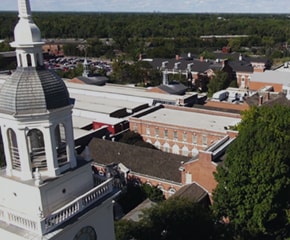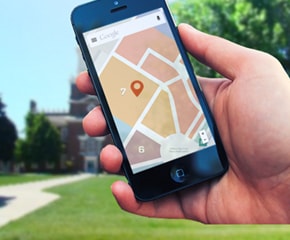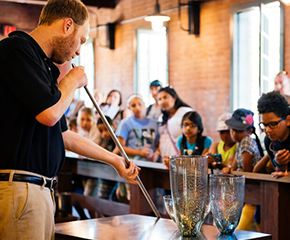
Creating Our Campus
Creating Greenfield Village
Ford’s historic village was to be organized around a village green, to include a courthouse, town hall, church, general store, tavern, and school. Homes were installed along a road beyond the green. Industrial buildings, such as a carding mill, sawmill, and gristmill, were made operational. A centerpiece of the Village was the re-creation of the Menlo Park, New Jersey, laboratory complex where Thomas Edison had invented his electric lighting system.
When we are through, we shall have reproduced American life as lived; and that, I think, is the best way of preserving at least a part of our history and tradition.
 Henry Ford
Henry Ford
Henry Ford engaged Ford Motor Company draftsman Edward J. Cutler to draw up plans. The first buildings began arriving in 1928. Laborers dug foundations, reconstructed buildings, cleared trees, laid out roads, and hauled supplies through muddy fields. Some buildings were designed right in the Village, at Ford’s request.
Logan County Courthouse Reconstructed in Greenfield Village, October 23, 1929
Artifact
Photographic print
Object ID
EI.1929.2200
Credit
From the Collections of The Henry Ford. Gift of Ford Motor Company.
On Exhibit
Not on exhibit to the public.
Related Objects
Get more details in Digital Collections at:
Logan County Courthouse Reconstructed in Greenfield Village, October 23, 1929
What is The Henry Ford?
The national attraction for discovering your ingenuity while exploring America’s spirit of innovation. There is always much to see and do at The Henry Ford.
Susquehanna Plantation
Artifact
House
Date Made
circa 1835
Summary
Henry Carroll owned this Maryland house on the Patuxent River in the decades before and after the Civil War. Its form -- one room deep with porches -- invited cooling breezes in the warm, humid climate. In 1860, the Carrolls raised tobacco and wheat on their 700-acre plantation. Seventy-five enslaved African Americans provided the skill and labor that supported the Carroll family's comfortable life.
Place of Creation
Object ID
42.209.1
Credit
From the Collections of The Henry Ford.
Get more details in Digital Collections at:
Susquehanna Plantation
What is The Henry Ford?
The national attraction for discovering your ingenuity while exploring America’s spirit of innovation. There is always much to see and do at The Henry Ford.
Susquehanna Plantation House at Its Original Site, Saint Marys County, Maryland, 1942
Artifact
Photographic print
Summary
Susquehanna Plantation, home to the Carroll family, was one of the largest, most productive farms in southern Maryland during the 1800s. Its success was made possible through the labor of 75 enslaved African Americans. The Maryland plantation house on the Patuxent River--one room deep with long front and back porches designed for ventilation--is seen here at its original site.
Object ID
64.167.188.P.70080
Credit
From the Collections of The Henry Ford. Gift of Ford Motor Company.
Location
By Request in the Benson Ford Research Center
Related Objects
Get more details in Digital Collections at:
Susquehanna Plantation House at Its Original Site, Saint Marys County, Maryland, 1942
What is The Henry Ford?
The national attraction for discovering your ingenuity while exploring America’s spirit of innovation. There is always much to see and do at The Henry Ford.


Interior of Logan County Courthouse at Its Original Site, circa 1900, Used as a Private Residence
 Details
Details
Interior of Logan County Courthouse at Its Original Site, circa 1900, Used as a Private Residence
Artifact
Photographic print
Summary
Between 1840 and 1847, Abraham Lincoln tried cases as a traveling lawyer in this courthouse when it was located in Postville (later Lincoln), Illinois. When the Logan County seat moved to Mt. Pulaski, this courthouse was reused as a general store, jail, post office, and private dwelling. Henry Ford purchased it in 1929 and brought it to Greenfield Village.
Object ID
EI.1929.P.188.1150
Credit
From the Collections of The Henry Ford.
On Exhibit
Not on exhibit to the public.
Related Objects
Get more details in Digital Collections at:
Interior of Logan County Courthouse at Its Original Site, circa 1900, Used as a Private Residence
What is The Henry Ford?
The national attraction for discovering your ingenuity while exploring America’s spirit of innovation. There is always much to see and do at The Henry Ford.
Wright Home--Reconstruction--Item4
Artifact
Photographic print
Summary
Henry Ford relocated the Wright brothers' home and cycle shop from Dayton, Ohio, to Greenfield Village. While the buildings sat a few blocks apart in Dayton, Ford placed them side-by-side at his Dearborn, Michigan, museum complex. Orville Wright and Charlie Taylor, the mechanic who built the engine for the 1903 Wright Flyer, assisted to ensure the project's accuracy.
Place of Creation
Object ID
P.188.20427
Credit
From the Collections of The Henry Ford. Gift of Ford Motor Company.
On Exhibit
Not on exhibit to the public.
Related Objects
Get more details in Digital Collections at:
Wright Home--Reconstruction--Item4
What is The Henry Ford?
The national attraction for discovering your ingenuity while exploring America’s spirit of innovation. There is always much to see and do at The Henry Ford.
Building the Museum
While Cutler labored in the muddy fields of Greenfield Village, architect Robert O. Derrick was designing a large indoor museum adjacent to the historical village to house the objects Ford had collected. Derrick suggested that the façade should resemble Independence Hall and related buildings of Philadelphia, with a large “Exhibition Hall” in back.
Since Henry Ford had rejected the notion of storage rooms, nearly everything had to be exhibited out in the open. The twelve-acre museum contained a glorious assemblage of stuff. To Ford, that assemblage represented the evolution of technological progress.
For nearly a decade after the museum officially opened to the public in 1933, visitors found it a work in progress. The exhibits would not be completed until the early 1940s.

Light’s Golden Jubilee
Henry Ford decided on October 21, 1929, as the dedication date for his new museum and village—marking the fiftieth anniversary of Thomas Edison’s first successful experiment with a suitable approach to manufacturing an incandescent lamp.
The night of the “Light’s Golden Jubilee” celebration, crowds cheered as President Hoover, Edison, and Ford ceremoniously arrived in a train pulled by an 1850s locomotive.
After an elegant dinner in the museum, the three men went out to the restored Menlo Park Laboratory in Greenfield Village. There, the 82-year-old Edison re-created the lighting of his incandescent lamp. The event was broadcast live over national radio.
Henry Ford named his new complex The Edison Institute of Technology, to honor his friend and lifelong hero Thomas Edison.

A Working Village
Henry Ford didn’t consider Greenfield Village finished upon opening. He continued to select homes, mills, and shops that he felt best reflected the way Americans had lived and worked, or that were associated with famous people he admired. Individuals even began to offer Ford historic structures for his Village.
By the mid-1930s, several Village shops were staffed by people demonstrating traditional craft skills, including glassblowers, blacksmiths, weavers, shoemakers, and potters. Visitors to Greenfield Village not only had the pleasure of watching the craftsmen work, they could also buy samples of their hand-crafted products. Craftsmen like brick makers and sawyers supported the Village restoration efforts.
By the early 1940s, Greenfield Village had grown to over 70 buildings.
Mr. Ford dislikes mere ‘dead’ exhibitions of things; he wishes to see them in action.
 Frank Campsall
Secretary to Henry Ford, Reminiscences
Frank Campsall
Secretary to Henry Ford, Reminiscences













